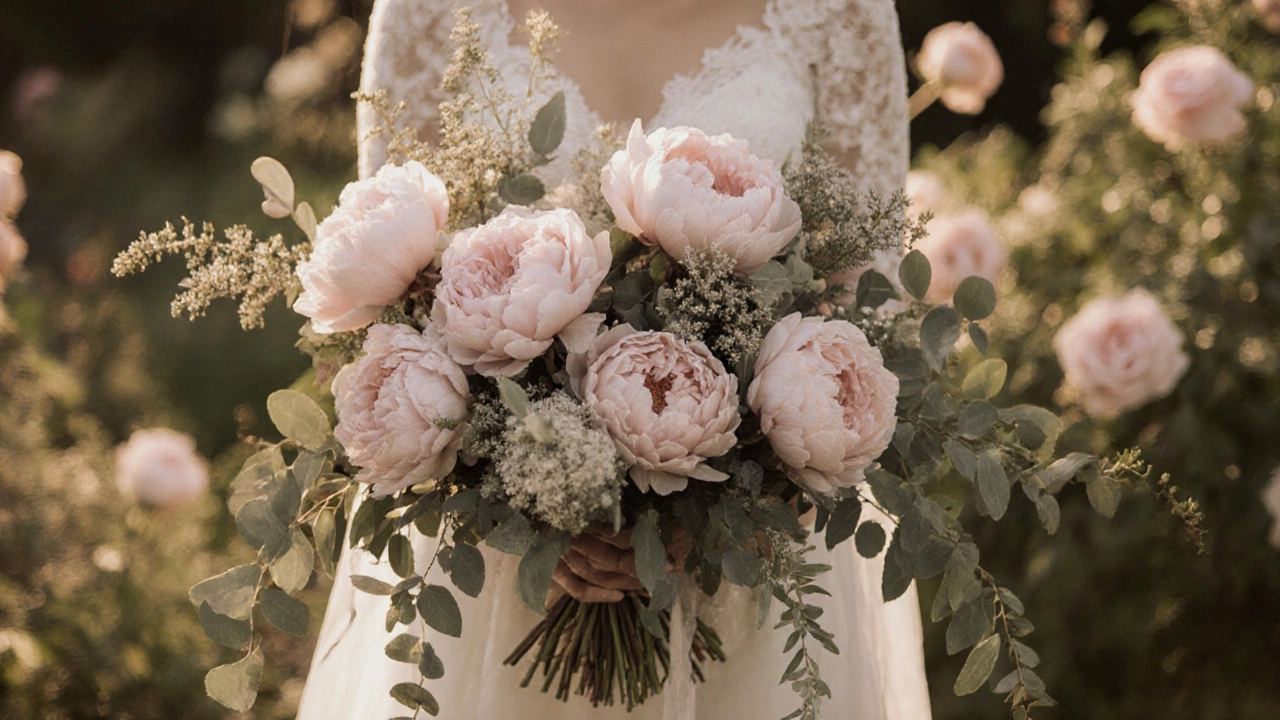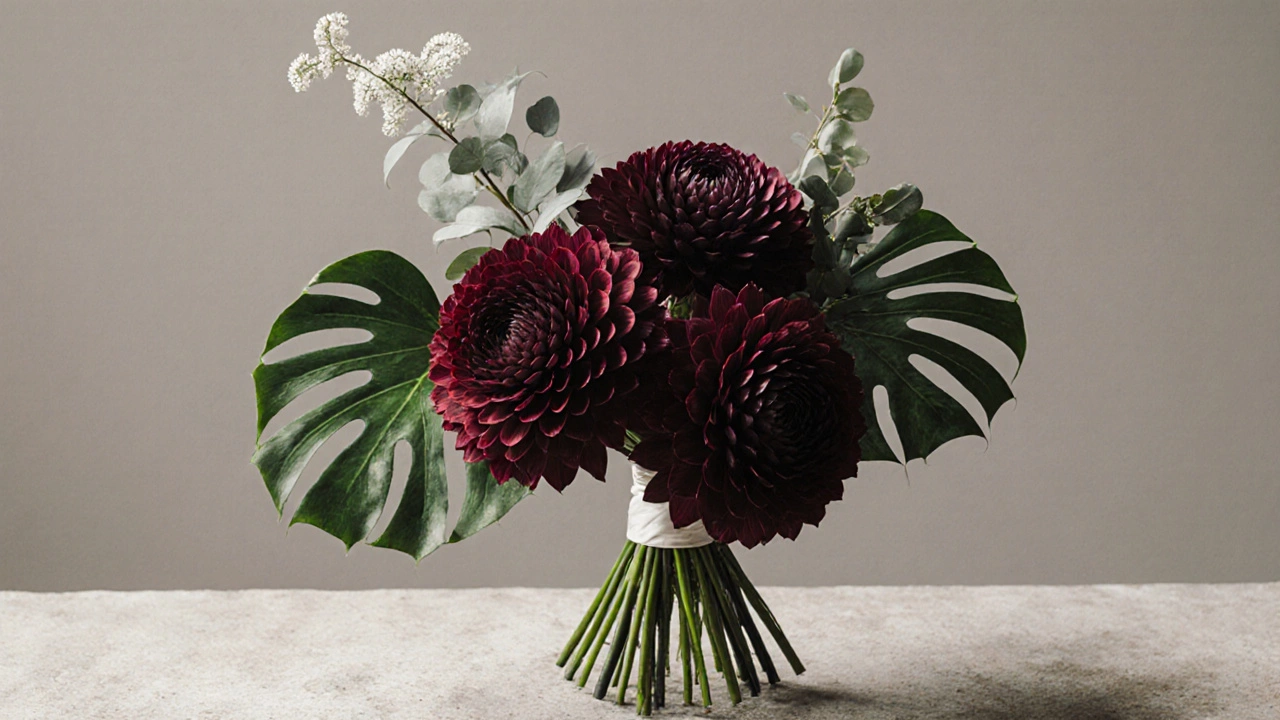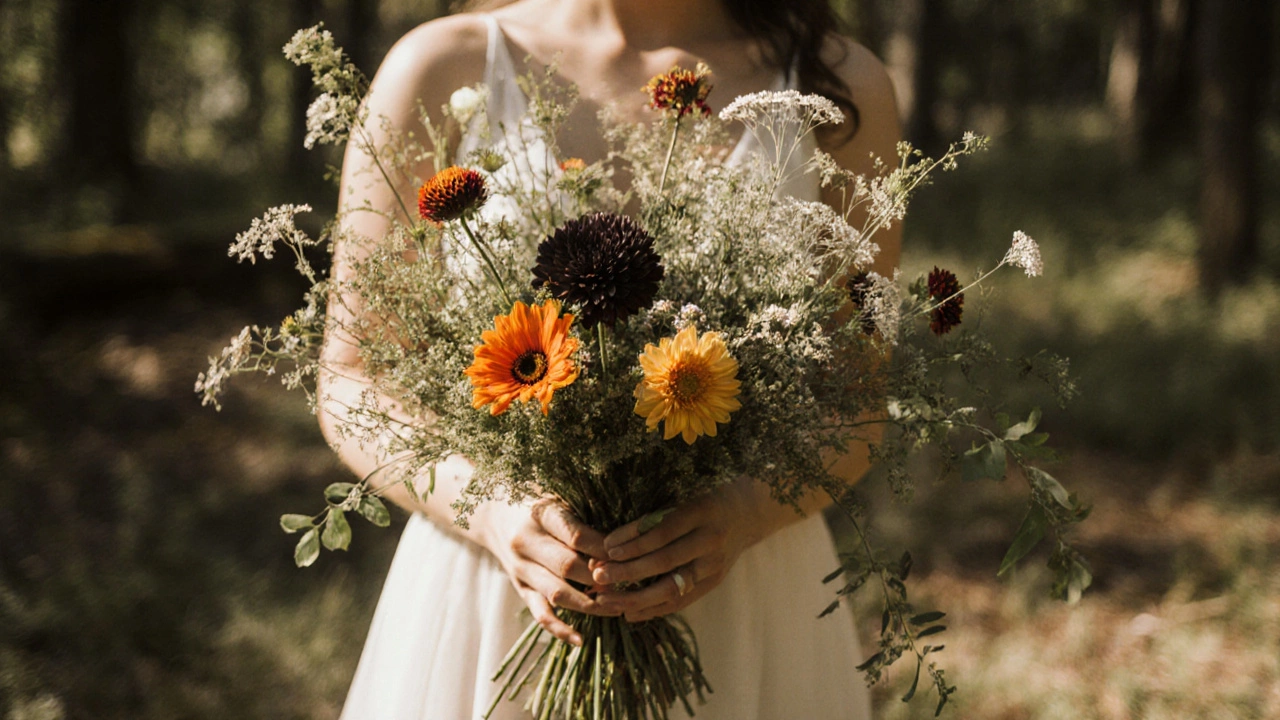What Flowers Look Best in a Bouquet for Weddings?
 Oct, 28 2025
Oct, 28 2025
Wedding Bouquet Compatibility Checker
Choose your wedding details below to get personalized bouquet recommendations based on the article content. Select one option per category.
Recommended Bouquet Flowers
Tip: These flowers last well for your season and match your dress style. Always ask your florist about fresh options.
Flowers to Avoid
Choosing the right flowers for a wedding bouquet isn’t just about what’s pretty-it’s about what lasts, what feels right, and what works with your whole look. Too many brides pick flowers based on photos they’ve seen online, only to realize on their wedding day that the blooms wilt by noon, clash with their dress, or smell too strong. The best bouquet flowers balance beauty, durability, and personal meaning.
Peonies: The Classic Romance
Peonies are the go-to for brides who want lush, full, and undeniably romantic bouquets. Their big, ruffled petals give off that soft, dreamy vibe that fits perfectly with vintage or garden-style weddings. They’re expensive, yes-often $5 to $8 per stem-but they’re worth it if you want that instant wow factor. Peonies bloom in late spring to early summer, so if your wedding is in May or June, they’re ideal. If you’re marrying in winter, ask your florist for cold-stored peonies-they’ll be available, but expect to pay more.
They pair beautifully with dusty miller, eucalyptus, and ranunculus. Avoid mixing them with overly bright or spiky flowers like protea or bird of paradise; it breaks the softness.
Roses: Timeless, But Not Always Simple
Roses are the most common wedding flower for a reason: they’re reliable, available year-round, and come in every color imaginable. But not all roses are created equal. Standard garden roses have a looser, more natural shape than the stiff, perfect blooms you see in supermarkets. For bouquets, go for garden roses-they’re more fragrant, have a fuller petal count, and look less like a grocery store arrangement.
White and blush garden roses work best with most dresses. Deep reds are bold and dramatic, great for fall or evening weddings. Avoid mixing too many rose varieties in one bouquet-it can look cluttered. Stick to one or two types, and let the texture do the talking.
Hydrangeas: The Volume Powerhouse
If you want a big, lush bouquet without spending a fortune on dozens of individual stems, hydrangeas are your secret weapon. Each bloom cluster is made up of 50 to 100 tiny florets, so you need fewer stems to fill space. They’re especially good for brides who want a full, rounded bouquet that feels substantial in the hands.
Hydrangeas are water hogs, though. They need to be kept in water constantly, and if they dry out, they’ll wilt fast. That’s why they’re not ideal for outdoor weddings in hot weather unless your florist uses special hydration techniques. Stick to white, cream, or soft blue hydrangeas-they blend with almost any palette. Avoid pairing them with delicate flowers like baby’s breath; they’ll overpower them.
Dahlias: Bold, Structured, and Unforgettable
Dahlias are the flower for brides who want something unique but still elegant. Their geometric petals, sharp edges, and rich colors make them stand out. They come in everything from deep burgundy to pale pink, and even striped varieties. Dahlias hold up well in heat and last longer than peonies or ranunculus, making them perfect for summer or autumn weddings.
They work best in modern, minimalist bouquets. A single stem of dark dahlia surrounded by greenery looks stunning. Avoid using too many types of flowers with dahlias-they’re strong enough to be the star. Pair them with leatherleaf fern, salal, or even succulents for an unexpected twist.

Tulips: Simple, Elegant, and Seasonal
Tulips are underrated. They’re affordable, easy to arrange, and have a quiet elegance that works for both casual and formal weddings. Their long, graceful stems make bouquets feel light and airy. They’re at their peak in spring-March to May-so if you’re marrying then, they’re a smart pick.
They don’t have a strong scent, which is great if you’re sensitive to fragrance. Tulips keep growing after they’re cut, so your bouquet might look taller by the end of the day. That’s charming, but it means your florist needs to cut them longer than usual and secure them well. Stick to single-color bunches: soft pink, creamy white, or deep purple look best.
Orchids: Sleek, Modern, and Low-Maintenance
Orchids are the choice for brides who love sleek, architectural beauty. Phalaenopsis orchids-those white, moth-like blooms-are the most popular for weddings. They last for weeks after being cut, don’t need much water, and look incredible in minimalist arrangements. They’re perfect for beach weddings, modern venues, or brides wearing clean-lined gowns.
They’re not cheap, but you don’t need many. One or two stems can anchor a whole bouquet. Pair them with monstera leaves, white eucalyptus, or even metallic accents for a luxe feel. Avoid mixing them with fluffy flowers like peonies or hydrangeas-it creates visual chaos.
Wildflowers: Rustic, Real, and Full of Character
Wildflowers aren’t just for boho brides. A bouquet made of locally foraged blooms-think cosmos, yarrow, feverfew, and Queen Anne’s lace-feels personal and alive. They’re inexpensive, seasonal, and full of movement. In Australia, native wildflowers like banksia, waratah, or grevillea add local charm and last surprisingly well.
The trick is balance. Too many wildflowers can look messy. Work with your florist to pick 3 to 5 types, and anchor them with a few stems of greenery or a single bold bloom like a dahlia or rose. This keeps it intentional, not random.

What Flowers Should You Avoid?
Not all pretty flowers make good bouquet choices. Here are a few to skip:
- Lilies (especially Oriental lilies)-they shed pollen like crazy and can stain dresses. If you love lilies, go for calla lilies instead-they’re clean and elegant.
- Tulips (if not handled right)-they keep growing and can bend awkwardly. Always ask your florist to cut them extra long and use floral tape to hold the stems.
- Chrysanthemums-they look like daisies but have a strong, sometimes unpleasant odor. Save them for funeral arrangements.
- Gladiolus-they’re tall and stiff, making bouquets feel top-heavy and awkward to hold.
- Marigolds-too bright, too casual, and often smell like cat urine. Avoid unless you’re going for a very specific, intentional look.
How to Choose Based on Your Dress and Theme
Your bouquet should complement your dress, not compete with it. Here’s how to match them:
- Ball gown or lace dress → Go for full, soft blooms like peonies, garden roses, and hydrangeas. Add trailing greenery for movement.
- Minimalist or slip dress → Choose structured flowers like orchids, dahlias, or single stems of calla lilies. Less is more.
- Boho or beach wedding → Wildflowers, succulents, and native Australian blooms like banksia or kangaroo paw. Keep it loose and natural.
- Winter or formal wedding → Deep red roses, anemones, or even dried elements like pampas grass. Add evergreen sprigs for texture.
Color matters too. If your dress is ivory or cream, avoid yellow or orange flowers-they’ll make the dress look dingy. Stick to whites, blushes, soft pinks, and muted greens. For a bold dress, let the flowers be neutral.
Pro Tips from Real Florists
- Order your bouquet flowers at least 6 weeks ahead. Popular blooms like peonies and dahlias get booked early.
- Ask for a test arrangement two weeks before the wedding. This lets you see how the colors look together and if the flowers are fresh enough.
- Bring a swatch of your dress fabric to your florist. They’ll match the tones perfectly.
- Don’t forget about the bouquet’s weight. A huge, dense bouquet can hurt your arms after hours. Go lighter if you’re dancing all night.
- Keep a spray bottle of water handy. A quick mist on the bouquet before photos helps it look fresh.
At the end of the day, your bouquet should feel like you-not a Pinterest pin. If you love the smell of garden roses, go for them. If you grew up picking wildflowers in the bush, let that be your inspiration. The best bouquet isn’t the most expensive one-it’s the one that makes you smile when you hold it.
What flowers last the longest in a wedding bouquet?
Orchids, dahlias, and calla lilies last the longest-often 5 to 7 days after being cut. Peonies and tulips are beautiful but more delicate, lasting 2 to 3 days. Hydrangeas need constant hydration and wilt quickly if not kept moist. For a bouquet that holds up all day, choose orchids or dahlias as your base.
Can I use seasonal flowers for a winter wedding?
Absolutely. Winter weddings work beautifully with deep red roses, anemones, hellebores, and even dried elements like pampas grass or eucalyptus pods. In Australia, native flowers like banksia, waratah, and bottlebrush are in season and add unique texture. Avoid flowers that only bloom in spring, like peonies, unless you’re okay with paying premium prices for cold-stored blooms.
Should I match my bouquet to my bridesmaids’ flowers?
Not necessarily. Your bouquet should stand out as the focal point. Bridesmaids’ flowers can echo your palette but should be simpler-smaller, fewer types, or just single stems. A good rule: your bouquet has 3 to 5 flower types; theirs have 1 or 2. This creates hierarchy without clashing.
Are artificial flowers a good option for wedding bouquets?
High-quality silk or handcrafted artificial flowers can look stunning and last forever. They’re great for brides with allergies, those planning destination weddings, or anyone who wants to keep their bouquet. But cheap plastic flowers look obvious and cheap. If you go this route, invest in real-looking ones from a specialist-look for petals with texture and slight color variation, not uniform, glossy plastic.
How much should I budget for wedding flowers?
In Australia, a bridal bouquet typically costs between $150 and $400, depending on the flowers. Peonies and orchids push the price up; wildflowers and greenery keep it lower. Overall, flowers for a wedding (bouquets, centerpieces, ceremony arch) usually take up 8% to 15% of your total budget. Don’t overspend on the bouquet alone-make sure it fits into your whole floral plan.
Next Steps: What to Do Now
Start by pinning 5 to 10 bouquet photos you love. Then, look closely: What flowers do you see? What’s the shape? Is it loose or tight? Is there greenery? Share those with your florist-they’ll know what’s in season and what works locally. Don’t just say, “I want something pretty.” Say, “I love this bouquet with peonies and eucalyptus, but I need it to last all day in 30-degree heat.” That’s the kind of detail that gets you the perfect arrangement.
Book your florist early. The best ones get booked 6 to 12 months in advance, especially for spring and summer weddings. And don’t forget to ask for a sample bouquet before the big day. It’s the only way to know if the colors and texture are really what you imagined.